Coin Rarities & Related Topics: News and Analysis regarding scarce coins, markets, and coin collecting #375
A Weekly CoinWeek Column by Greg Reynolds …..
The vast majority of the coins in the Pogue Family Coin Collection, especially the core collection of U.S. coins dating from 1793 to 1839, were consigned to Stack’s Bowers in 2014 to be sold in a series of auctions. As suspense builds for the fifth sale, it is appropriate to reflect upon the auctions of the Pogue Collection in the context of the great sales of all time.
The first Pogue sale was on May 24, 2015. The fifth and apparently last of the series will be conducted in Baltimore on March 31, as explained in part 20 and part 21 of this series.
Before citing auctions of other great collections, it is important to emphasize the scope and importance of the Pogue Collection, which is phenomenal in some ways while being limited in others. The Pogues did not build sets of all series of classic U.S coins. More than 90% of the coins in the five sales were dated before 1840. Before 2004, the Pogues were limiting their collection to pre-1840 U.S. coins, with but a few exceptions.
The focus on the period 1793-1839 period is consistent with a tradition that dictates that design types that started before 1837 and ended before 1840 are ‘early U.S. coins’. Including all U.S. coins dated until 1839 is a twist on this tradition, and makes the boundaries of the core Pogue Collection clear to anyone who has access to a standard price guide, like those found at the PCGS, NGC or numismedia.com web sites.
The epic collections and corresponding great auctions of the past did not emphasize early U.S. series in this manner. They all included extensive runs of coins from later time periods. Even so, the amazing accomplishments of the Pogues and their advisors in the field of pre-1840 U.S. coins are worth emphasizing repeatedly. This core (1793-1839) Pogue Collection is incredibly cool and is meaningful to a wide range of coin collectors.
The auctions of epic collections are extremely important to the coin community. They are just as important to many collectors of classic U.S. coins who cannot afford the rarities offered as they are to the people who can afford them.
These great sales have been part of the culture of coin collecting in the U.S. ever since the 1850s. Rarities from the auctions of the McCoy Collection in 1864 and the Mickley Collection in 1867 are often discussed in the present.
Two weeks ago in part 21 on copper type coins, and in a discussion last year, reasons were put forth as to why the Pogue sales are important to coin collectors who cannot afford coins in the Pogue Collection. I won’t repeat them here.
It is relevant that books about Eliasberg, the Garrett Collection and Eric Newman are popular among collectors. John J. Pittman is a legend who is frequently discussed in the present, including repeated references to his approach to collecting. Published interviews with Pittman are themselves collected and studied.
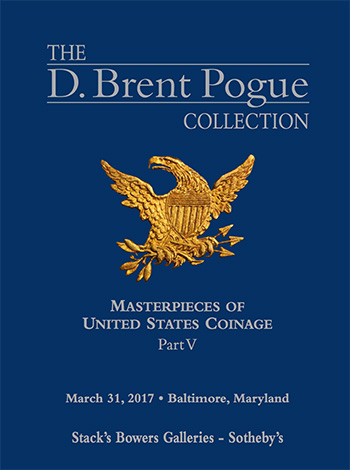 In talks that I have delivered to coin clubs, collectors–some of whom are poor–have shown tremendous interest in learning about the Eliasberg, Norweb, and Pittman collections. They read about these collections, recognize references to them in various publications and discuss them with their friends. Attention paid to epic collections and corresponding auctions contributes to generating enthusiasm for coins and excitement within the coin community.
In talks that I have delivered to coin clubs, collectors–some of whom are poor–have shown tremendous interest in learning about the Eliasberg, Norweb, and Pittman collections. They read about these collections, recognize references to them in various publications and discuss them with their friends. Attention paid to epic collections and corresponding auctions contributes to generating enthusiasm for coins and excitement within the coin community.
Here is a list of other great collections sold at public auction that are particularly relevant to the Pogue sales. The names of the auction firms are beside the point. The years during which auctions were held are cited along with the last names of collectors. McCoy (1864), Mickley (1867), Parmelee (1890), Cleneay (1890), Stickney (1907), Earle (1912), Jenks (1921), Boyd (1944-45), JAS (1975, ’89-90, ‘94-95), Norweb (1987-88), Eliasberg (1982, 1996-97), Pittman (1997-98) and Newman (2013-14).
The coins in the Pogue Collection can be practically compared to the coins dating from 1793 to 1839 in other epic collections that have been auctioned since 1975. In this category, the Pogue Collection is dramatically superior to the JAS Collection, which did have more than a few exceptional pre-1840 coins, especially dimes and quarters. The Boyd-JAS-Gardner 1822 dime comes to mind, which I covered in 2014.
JAS is an abbreviation of James A. Stack, Sr. As this collector was not related to the famous family who owned an auction firm, it is awkward to spell out this name and it would be confusing to refer to the JAS Collection as the “Stack Collection”.
The James A. Stack, Sr. (JAS) Collection was auctioned by Stack’s (NY) in at least five different sales, during five different years, within a span of more than 20 years. The JAS collection is not as well recognized as some of the other epics. He was in the textile business and he died during the early 1950s. The JAS Collection was especially impressive in the realm of Liberty Seated coins.
John Pittman
Undoubtedly, John Pittman was one of the most famous collectors in the 20th century. He was a vocal presence at innumerable events. Furthermore, he was a past president of the American Numismatic Association (ANA) and was very much involved with coin clubs. He exhibited coins at many conventions, and often literally carried rare coins around with him to show people in a wide variety of settings.
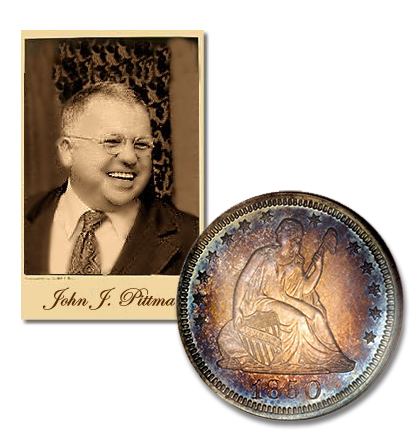 Indisputably, the Pogue Collection is superior to the Eric Newman and John Pittman collections in the area of U.S. coins dating from 1793 to 1839. Other than early Proofs, early U.S. coins were not Pittman’s primary focus. He did collect business strikes in early U.S. series ‘by date’ but, in most instances, Pittman was satisfied with markedly circulated or sub-par representatives of a date. He did not strategize to acquire gems or condition census representatives of business strikes dating from 1793 to the 1820s.
Indisputably, the Pogue Collection is superior to the Eric Newman and John Pittman collections in the area of U.S. coins dating from 1793 to 1839. Other than early Proofs, early U.S. coins were not Pittman’s primary focus. He did collect business strikes in early U.S. series ‘by date’ but, in most instances, Pittman was satisfied with markedly circulated or sub-par representatives of a date. He did not strategize to acquire gems or condition census representatives of business strikes dating from 1793 to the 1820s.
During the late 1940s and ’50s, there was little interest in pre-1860 Proofs and full-time dealers could tell the difference between Proofs and business strikes, anyway. Pittman found those to be the best values in terms of rarity, quality, and aesthetics.
For example, Pittman had a Very Fine grade 1793 half cent, an Extremely Fine 1794, a Very Fine 1795 and a Good grade 1796 half cent ‘with pole’. The Pogues had startling gems of all these dates. Pittman was not seeking gem business strikes.
In terms of large cents, Pittman apparently did not have a Chain cent. The Pogues had one of the three best Chain cents that survive and a ‘mint state’ chain cent of a rarer variety.
Pittman had a Very Good grade Wreath Cent, and an Extremely Fine grade 1794 cent. It is true that Pittman had gem-quality large cents, some of which were undergraded. For most dates in the series of large cents, however, Pittman had circulated representatives. In contrast, the Pogues acquired Gems of most dates and completed one of the all-time best sets of large cents ‘by date’, most of which will be auctioned on March 31.
Generally, for U.S. coin types that began at some point from 1793 to 1829, Pittman had representatives of many dates though the quality was inconsistent. In series of early U.S. coins, it was not unusual for Pittman to have Very Fine to EF grade representatives of some of the least scarce dates, along with some MS-63 to -65 grade representatives of scarcer dates.
Pittman did not seem to have uncirculated 1794, ’95, or ’96 half dimes. Although the Glenn-Gardner-Pogue 1802 is better, Pittman’s 1802 half dime is one of the best of fewer than 30 known. The Pittman and Pogue 1801 half dimes are the same coin, which is PCGS-graded as AU-58 and CAC-approved.
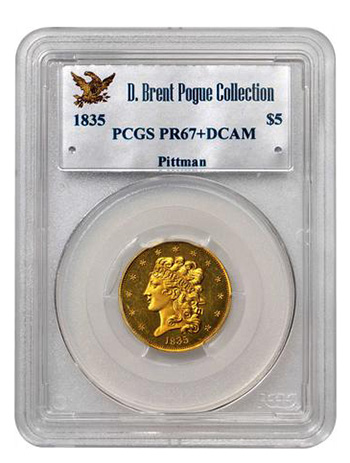 Although the Pogue Collection contained a better set of bust dimes, Pittman’s set was impressive in spite of some oddly unimpressive members. While the 1822 is rare, it is difficult to obtain a decent one. In the Pittman I catalogue (1997), David W. Akers reveals that Pittman’s 1822 dime has “damage” and “Good” level details.
Although the Pogue Collection contained a better set of bust dimes, Pittman’s set was impressive in spite of some oddly unimpressive members. While the 1822 is rare, it is difficult to obtain a decent one. In the Pittman I catalogue (1997), David W. Akers reveals that Pittman’s 1822 dime has “damage” and “Good” level details.
Pittman’s lack of a 1796 and circulated examples of several dates makes it more difficult to meticulously compare his bust quarters to the mostly gem quality bust quarters in the Pogue set, which are incomparable. Even so, Pittman did have an incredibly important group of bust quarters.
Among early gold series, Pittman had some important rarities and a few very high-quality pieces. It seems, however, that he wasn’t seriously collecting these ‘by date’. Pittman’s early gold business strikes are not in the same league as those in the Pogue Collection.
As for pre-1840 Proof gold, Pittman had two or three coins that were later in the Pogue Family Collection. The Parmelee, Pittman and Pogue Proof 1833 half eagles are all the same coin. The same is true of a Proof 1835 half eagle! Also, there are a few Capped Bust halves that were in both the Pittman and Pogue Collections.
Among pre-1840 U.S. coins, Pittman’s collection will be remembered for Proofs and for a few important pre-1808 rarities. With a small number of exceptions, pre-1820 coins are not among the best remembered coins in the Pittman Collection. Indeed, it is best remembered for U.S. silver and gold coins minted from 1820 to 1890.
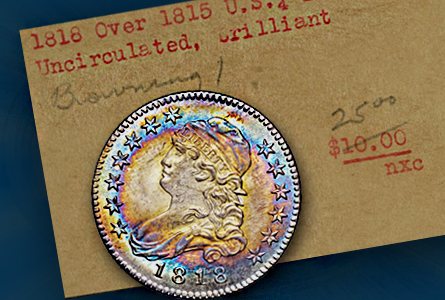 Eric Newman
Eric Newman
Eric P. Newman is even more of a legend than John J. Pittman. Newman’s collection will always be remembered for pre-1793 American items, including colonials, state coinage, private patterns, tokens and medals, plus paper money. Newman, though, did collect U.S. federal coinage, much of of which he obtained from the estate of Col. E. H. R. Green, with the cooperation of St. Louis dealer Burdette Johnson.
The Pogues had a phenomenal 1794 silver dollar and two great 1795 Flowing Hair dollars, plus two wonderful, MS-66 grade 1795 Draped Bust silver dollars. Nonetheless, Newman probably had a a better group overall of business strike Draped Bust silver dollars. In almost every other category of pre-1840 U.S. coins, however, the Pogue Collection was superior to the Newman Collection.
Quarters constituted the most impressive group of bust silver coins in the Newman Collection. The Norweb family had an impressive set of bust quarters as well. This, though, was an area where the Pogue Collection excelled to a miraculous extent.
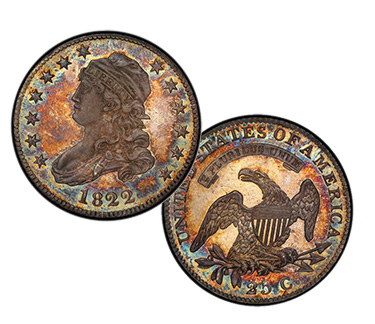 I am certain that the Pogues had the all-time greatest collection of Capped Bust quarters that was ever sold. There is a relevant private collection that I have not seen. The Pogue set of Capped Bust quarters contained so many highly ranked or otherwise incredible pieces, both business strikes and Proofs, that it is almost impossible that any past collection of Capped Bust quarters could be rated higher.
I am certain that the Pogues had the all-time greatest collection of Capped Bust quarters that was ever sold. There is a relevant private collection that I have not seen. The Pogue set of Capped Bust quarters contained so many highly ranked or otherwise incredible pieces, both business strikes and Proofs, that it is almost impossible that any past collection of Capped Bust quarters could be rated higher.
The Newman run of Draped Bust quarters is commensurable. The Pogue set of Capped Bust quarters, however, was unbelievably amazing.
Gene Gardner was a legend in our own time, and he formed an epic collection, too. It did not, however, contain any pre-1840 gold coins. The other collections cited here contained sets or at least notable runs of rare and or very high-quality pre-1840 U.S. coins in copper, silver and gold.
Epics in the Past
Veteran researchers may note that the auction of the Joseph Mickley Collection in October 1867 did not contain early gold coins. W. Eliot Woodward was the consignor, as he had purchased the Mickley Collection intact. Mickley, however, collected U.S. gold coins ‘by date’, and the Mickley sets of gold coins were sold privately, probably also in 1867, to William Sumner Appleton. The 1793 to 1839 U.S. coins that were in the Mickley Collection are in the same class as the Pogue Collection.
The Dunham (1941) and Atwater (1946) collections were sold in mail bid sales by B. Max Mehl under mysterious circumstances, and perhaps should not be listed along with true auctions of collections. It is not clear who owned the coins that were being offered. Mehl bought and sold coins before the sale closings, without revealing that he had done so.
In any event, it seems that, like most others before 1955, the Atwater and Dunham collections included many Very Fine to Extremely Fine condition coins in sets–even in cases where gem ‘mint state’ coins could have been obtained. It is almost impossible to trace most Atwater and Dunham coins. It is even more difficult to make sense of Mehl’s grading, which was ridiculous even in his own time.
During the first half of the 20th century, the Virgil Brand, Waldo Newcomer, and Col. E. H. R. Green Collections were handled privately (for the most part). Comparing any of these with the Pogue Collection would involve a great deal of hypothesizing, especially about variables that will remain forever elusive.
As the Garrett Collection had many rarities and unusual items rather than sets ‘by date’, the pre-1840 Garrett U.S. coins cannot be compared easily to related Pogue coins. The Pogue Collection features systematic sets ‘by date’. The Garrett Collection was mostly an assortment of exciting or otherwise interesting coins and patterns.
It is especially noteworthy that there were many Garrett Collection coins in the Pogue Collection. The Garrett 1795 half eagle and eagle are the most famous Garret pedigree coins in the Pogue collection, perhaps the finest known of each date. In an overview of the Pogue V sale, I discuss the Garrett Collection and the fact that the Pogue V sale will be held in the house where the Garrett Family Coin Collection resided for decades.
Norweb Family
The Garrett sales occurred from 1979 to 1981. The Norweb Family U.S. coins were auctioned not quite 10 years later, in 1987 and 1988. Q. David Bowers was the primary cataloguer of both collections.
The Norweb Collection was amazingly complete overall. Coin for coin, however, the pre-1840 U.S. coin issues in Pogue surpass those of the Norweb family for almost every series and in regard to most major rarities. There were phenomenal pre-1840 U.S. coins in Norweb, but the Norweb Family Collection had nowhere near the overall quality and depth in this area as the Pogue Family Collection did.
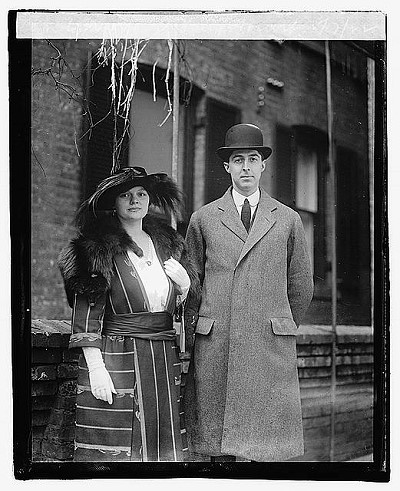 For example, the Pogue Collection had an amazing group of 18th-century half cents with many gems, certainly one of three all-time best such runs. In contrast, all the 18th-century U.S. half cents in the Norweb Collection were catalogued as grading below MS-63.
For example, the Pogue Collection had an amazing group of 18th-century half cents with many gems, certainly one of three all-time best such runs. In contrast, all the 18th-century U.S. half cents in the Norweb Collection were catalogued as grading below MS-63.
The Norweb family did have some fabulous half dimes, including the 1800 in the Pogue Collection, which is PCGS-graded as MS-68 and CAC-approved. The Norweb 1801 and the 1803, however, were listed as grading VF-20 in the catalogue in 1987.
The Norweb 1832 half dime, a very common date, was said to grade “AU-55” in the Norweb I catalogue. The Pogues had the Eliasberg 1832 half dime, which is PCGS-graded as MS-66 and has a gold sticker from CAC. I was cheerfully drawn to this coin.
I covered a later sale of the Norweb 1796 quarter in 2014. While a really neat coin, it is not nearly of the quality of the LA-Pogue 1796 quarter, which I wrote about in 2015. It would be easy to find many examples of very desirable pre-1840 Norweb coins that are inferior to corresponding coins in the Pogue Collection, though a few Norweb coins may be superior to corresponding Pogue coins.
The Norweb Collection is probably one of the dozen all-time best collections of classic U.S. coins. It was, however, something of an ‘Eliasberg lite’: not nearly as complete and not nearly of the general quality of the Eliasberg Collection, yet still an amazing collection overall.
Pogue Collection in Historical Context
As for collections auctioned before 1980, especially before 1955, the quality and aesthetics of most of the coins are mysteries now, as pictures and descriptions in past catalogues are usually not sufficient to match such coins to known coins in the present. Yes, much pedigree research has been done and much more pedigree research is viable. New knowledge regarding pedigrees is waiting to be discovered. Even so, most pedigree research relates to coins for which fewer than 35 are known in all grades or fewer than a dozen grade above 60.
So, it is extremely difficult to compare collections that were sold in such eras. Of course, reasoned hypotheses about individual coins, sets, and whole collections can be formed, as I have done, but it is unlikely that these can be substantiated with overwhelming factual detail.
Most of the collectors who formed comprehensive collections in the past were not all that concerned about the quality of each coin. They did not devote a great deal of time to focusing on the quality of representatives of relatively common dates. Rarities and better dates commanded far more attention, and the quality of the least scarce dates was not a priority until the middle of the 20th century, much more so since the advent of registry sets by PCGS and later NGC.
Before the 1950s, the grading in catalogue descriptions was extremely loose and hopelessly vague. Moreover, the abilities of the cataloguers then should be subject to question. A coin contemporaneously called “Extremely Fine” might grade anywhere from VF-25 to MS-66 in the present, if gradable at all.
Among collections that have been publicly auctioned over the last 40 years, only one rivals the Pogue Collection in regard to U.S. coins dating from 1793 to 1839. This is the all-time greatest collection of classic U.S. coins overall, the Eliasberg Collection. A comparison of Eliasberg pre-1840 coins to Pogue coins would require a separate discussion. It is pertinent that there were a large number of Eliasberg pedigreed coins in the Pogue Collection.
 It is not entirely fair to other collections to extrapolate pre-1840 U.S. coins and judge those separately. The Liberty Seated coins in some of the cited collections were phenomenal. Also, many of the collections in my list above had fabulous Proof gold coins dated after 1840, including Proof-only issues and other rare dates.
It is not entirely fair to other collections to extrapolate pre-1840 U.S. coins and judge those separately. The Liberty Seated coins in some of the cited collections were phenomenal. Also, many of the collections in my list above had fabulous Proof gold coins dated after 1840, including Proof-only issues and other rare dates.
For pre-1840 U.S. coins, the Pogue Collection has few serious competitors in the history of coin collecting (Parmelee, Brand, and Eliasberg are the leaders). It is theoretically plausible that Newcomer and Col. Green could each conceptually have had sets of pre-1840 U.S .series ‘by date’ that were commensurable to that of Pogue, but this is doubtful. They would not have cared as much about the quality of not-so-rare dates. Most of the great collectors before 1970 did not spend much time thinking about the quality of coins that were not rare as types, dates, or die pairings.
Opportunities in the Present
Rather than attempt to collect all classic U.S. coins from 1793 to 1934, or even through 1840, it is best to have specialties. In the future, quality-focused collectors will probably choose one metal, or two to five denominations.
Collecting one copper series, such as half cents, one silver series, such as quarters, and one gold series, such as half eagles, would be exciting.
It is sometimes not a good idea to start a set in a series that is currently very popular. Generally, there could be opportunities in half cents, quarters, quarter eagles, half eagles, and all series of Liberty Seated coins. Some, though not all, of the Liberty Seated coins in the Pogue V sale are terrific.
© 2017 Greg Reynolds
PCGS-Certified Large Cents Currently Available on eBay
[wpebayads]


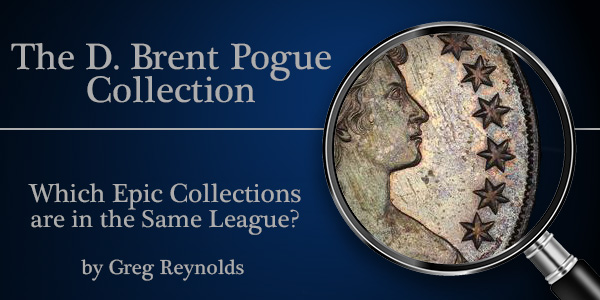



Very very informative!!